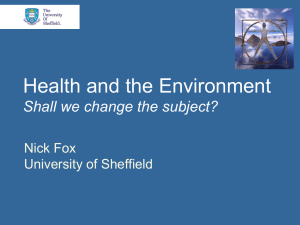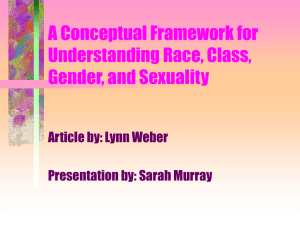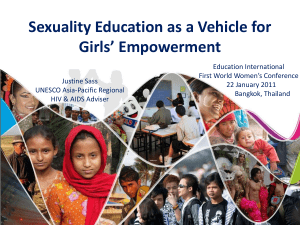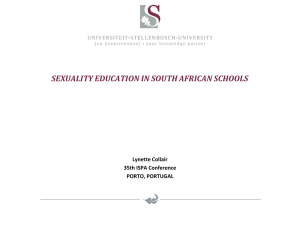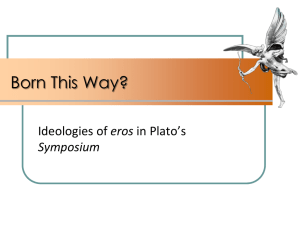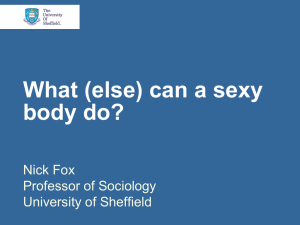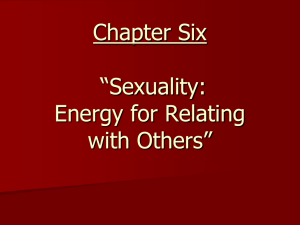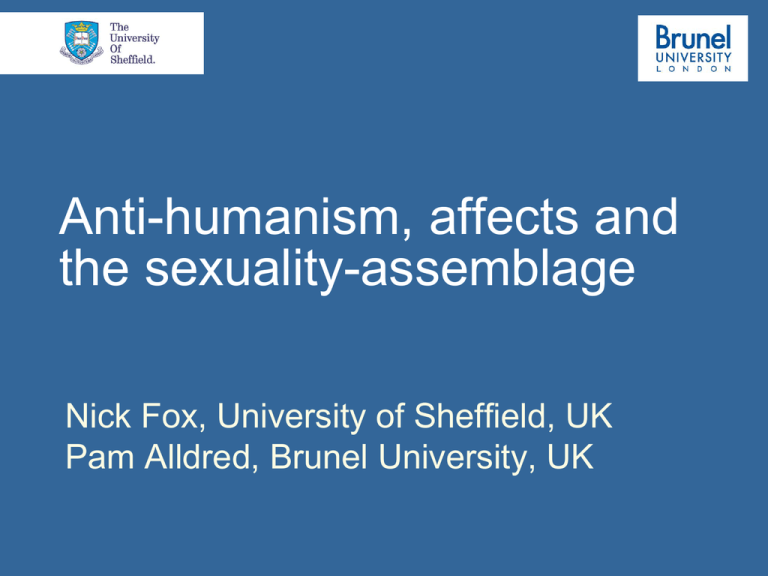
Anti-humanism, affects and
the sexuality-assemblage
Nick Fox, University of Sheffield, UK
Pam Alldred, Brunel University, UK
Introduction
• Rationale for the paper.
• Anthropocentrism and sexuality.
• Anti-humanism and sexuality.
• Study of young men’s sexuality.
• The hetero-masculinity assemblage.
Rationale for the paper
Two theoretical moves are required to resist
‘humanist enticements’ (e.g. individualism, free
will, identity) associated with sexuality.
1. Post-structuralism has shown how sexual
knowledgeabilities are culturally-specific.
2. Anti-humanist turn sees sexual bodies and
desires as products of an impersonal and
nomadic sexuality that flows between bodies,
things, ideas and social formations.
Anthropocentrism
• Gives priority to human bodies, human
subjects and human experience.
• Reflected in:
• Humanism
• Romanticism
• Individualism
• Identity politics
Sexuality and anthropocentrism
Anthropocentric accounts :
‘... classify sexual desires according to a very
limited number of formulaic syntheses of
genders and sexes: there is the norm
(heterosexuality), then an inversion of the
norm turned into an exclusive disjunction from
the norm (homosexuality), then a perversion
of the norm in a whole range of in-betweens
(bisexuality and, to a much lesser degree,
transsexuality).’
(Lambevski 2004: 306).
Anti-humanist approaches
• Human bodies and subjects are no longer
privileged as agents.
• Focuses instead on assemblages of bodies,
things, ideas, social institutions.
• Elements within assemblages affect and are
affected by each other.
• These flows of affect produce capacities in
bodies, collectivities and things.
Anti-humanism and sexuality
• Sexuality is an impersonal, nomadic flow of
affect within assemblages of bodies, things,
ideas and social institutions and formations.
• This flow produces sexual (and other) capacities
to desire in bodies, and hence manifestations of
sexuality.
• Sexuality is consequently both infinitely variable
and typically highly constrained (by capitalism,
patriarchy, heteronormativity, genitality ,etc. ).
From ontology to methodology
• Use social methods that:
• Explore the flows of affect in sexualityassemblages.
• Identify the forces that produce conventional
sexualities.
• Assess how to resist these forces.
The sexuality of young men
• Alldred & David’s study (2007) of young
people’s views of sex education and teenage
pregnancy.
• Focus group with eight white, working-class
young men in ‘alternative education’
provision; history of multiple exclusions and
tales of victimisation by teachers.
• Context: English town in industrial decline;
viewed as teenage pregnancy ‘hotspot’.
Data analysis methodology
• Noisy and riotous engagement, with
constant overlapping and interrupting.
• Approach the focus groups as
ethnography (‘writing culture’) rather than
interviews.
• No attempt to make claims of ‘authenticity’
or ‘identity’ by recourse to quotations from
the transcript.
1. Sexuality produced relationally
• Boastful heterosexualised masculinities
(initially understood as flirtation) is the
product of status hierarchical affects.
• This reflects location within a broader
assemblage of hetero-patriarchal,
economic and educational affects.
• These produce both ‘manual workers’
and a hetero-masculinist sexuality.
2. Sexuality as capacity
• The analysis sees the hetero-masculinity of
these young men not as a fixed attribute, but as
fleeting opportunities that produce actions and
desires in different contexts.
• These multiple capacities to affect and be
affected emerge from the assemblage of
bodies, things and social formations.
• Contrasts with Bourdieu ‘s ‘cultural capital‘ , in
which capital is owned (or lacked) by bodies.
3. Sexuality as contingent and
variable capacities
• The physical aggression in this group is a
reflection of the competitive affects within
the assemblage (e.g. competition for jobs
or particular girlfriends,).
• Capacities can variously produce heterosexuality; male-male aggression;
homosocial or homosexual intimacies (and
potential for other actions and desires).
The hetero-masculinity assemblage
boys - school exclusion - education system alternative education – jobless men - local
community norms – teenage pregnancy –
benefits - mechanic’s apprenticeship – cars –
driving – adult status – cigarettes – take-away
food – bodily maturation – height – sexual desire
– virginity –’girls’ – ‘being up-for-it’ – erections –
peer discourse on heterosex
Some conclusions
• Sexuality is a flow of affect within an
assemblage of human and non-human.
• There are myriad possible sexualities.
• Capitalism, patriarchy, commodification
and genitalism produce narrow sexualities.
• There is potential to resist, and explore
nomadic sexuality.
Anti-humanism, affects and
the sexuality-assemblage
Nick Fox, University of Sheffield
Pam Alldred, Brunel University




